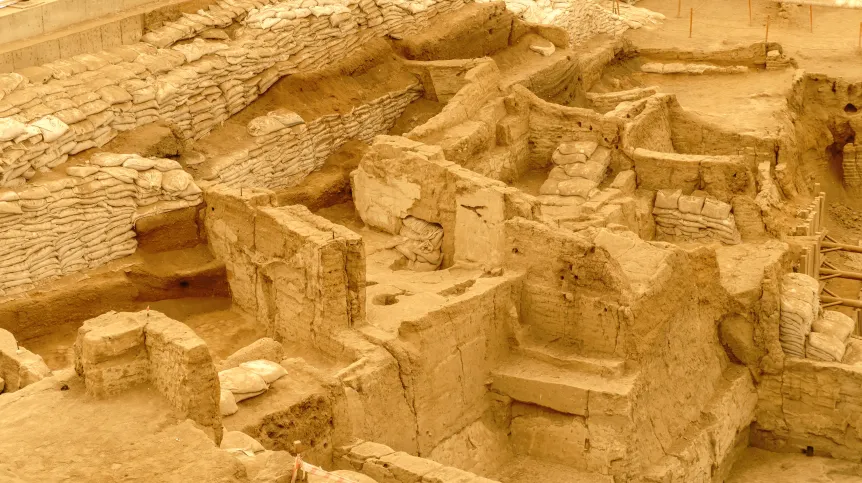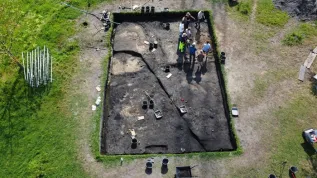
Women held a dominant social role in the Neolithic community of Çatalhöyük, according to new research published in Science.
The international study, based on genetic analysis of 131 ancient genomes from the site in central Turkey, resolves a long-standing debate about kinship, household composition, and the social status of women in Çatalhöyük, a settlement inhabited continuously from 7100 to 5950 BCE.
The project, led by geneticists from the Middle East Technical University in Ankara under the supervision of Mehmet Somel, was supported by an international team of archaeologists and physical anthropologists including from Adam Mickiewicz University in Poznań, Poland.
Chyleński's earlier 2019 study had suggested the same social patterns, but the new, larger dataset allowed definitive conclusions.
Çatalhöyük is famous for its densely clustered, rooftop-accessed homes and elaborate symbolic art, including prominent female figurines. Burial practices have long intrigued archaeologists—bodies were interred in cavities beneath house floors, leading to speculation over whether these were family tombs or community spaces.
The new study analysed over 400 skeletons. Despite poor DNA preservation, the researchers successfully sequenced genomes from 131 individuals. Kinship patterns revealed that early in the settlement’s history, people buried together were closely related. However, in later centuries, genetic ties among housemates declined.
‘The presence of a large number of non-biological relatives made it difficult to detect this regularity in previously published pilot studies, but the current results clearly indicate the greater persistence of female lines within the houses,’ Dr. Chyleński said.

This means that women stayed in their birth homes throughout their lives, while men likely moved away—the opposite of what was observed in many European Neolithic societies, where patrilineal systems dominated.
‘The genetic connection of people buried in the homes was mainly in the female line. That means that women remained in their homes and men left them,’ Chyleński said, adding: ‘This picture is completely inconsistent with the rules that guided the European Neolithic communities.’
‘The practice of accepting biologically unrelated people could have been a kind of form of foster care or adoption, and it was an important mechanism of consolidation of social bonds,’ the researchers said.
The study also found strong material evidence of greater social value placed on girls. Genetic testing made it possible to assign gender to children’s remains and compare grave goods across sexes, something that was not previously possible using only skeletal features.
‘It unexpectedly turned out that graves of girls contained over five times more items, such as beads and bracelets, bowls and baskets, pigment or stone blades, than comparable graves of boys," said Dr. Chyleński. ‘This practice continues throughout the existence of the Çatalhöyük settlement.’
The consistent burial pattern further supports the idea that women held elevated social status, not just symbolically but in daily life.
The symbolic importance of women appears to have peaked during Çatalhöyük’s final phase. Professor Arkadiusz Marciniak from the Faculty of Archaeology at Adam Mickiewicz University, who has led Polish excavations at the site for over 25 years, noted a parallel between social shifts and cultural flourishing.
‘The position of women becomes particularly dominant at the end of the main period of the functioning of the settlement, which had about a thousand inhabitants at the time,’ he said. ‘This corresponds to the intensification of ritual treatments, a large number of wall paintings with narrative scenes and special treatment of taurine cattle.’
But this period of female dominance also marked the beginning of the end for the Çatalhöyük model. The settlement eventually fragmented into smaller communities, and the population dispersed.
‘This means the end of the Middle Eastern Neolithic model based on the dominant role of women, and perhaps the beginning of a new stage, in which men are beginning to dominate, and which becomes so clear in the European Neolithic,’ Marciniak added.
Çatalhöyük has long fascinated scholars due to its scale, complexity, and artistic richness. But until now, there was no direct evidence to support long-standing theories that it may have been matriarchal or matrilineal.
‘Until now, they could not be thoroughly verified, because, apart from the presence of the figurines themselves, there was no other evidence," the researchers wrote.
Science in Poland, Ewelina Krajczyńska-Wujec (PAP)
ekr/ zan/













